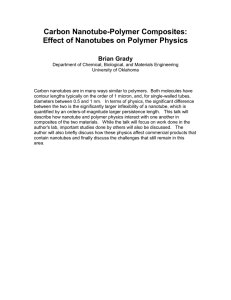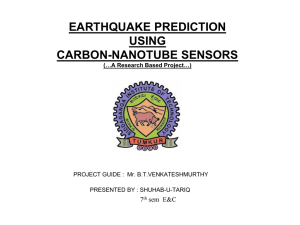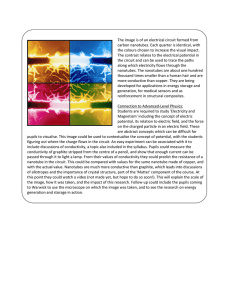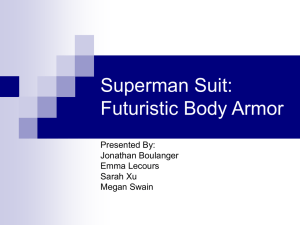Electrostatic Deflections and Electromechanical Resonances of
advertisement
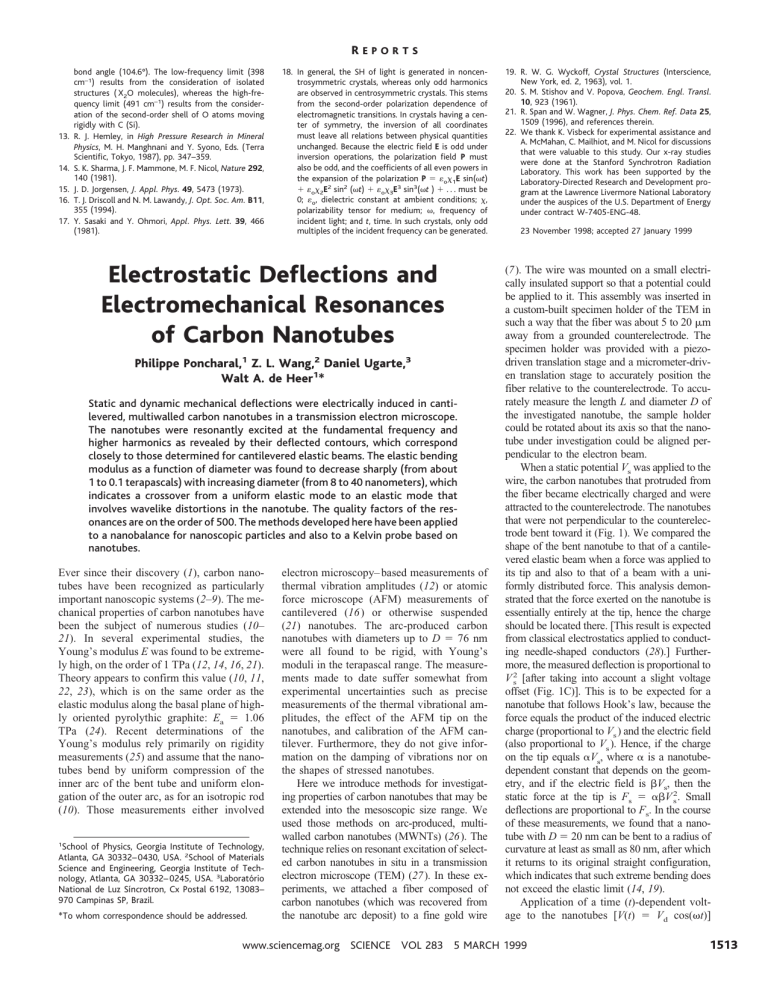
REPORTS
13.
14.
15.
16.
17.
bond angle (104.6°). The low-frequency limit (398
cm–1) results from the consideration of isolated
structures ( X2O molecules), whereas the high-frequency limit (491 cm–1) results from the consideration of the second-order shell of O atoms moving
rigidly with C (Si).
R. J. Hemley, in High Pressure Research in Mineral
Physics, M. H. Manghnani and Y. Syono, Eds. (Terra
Scientific, Tokyo, 1987), pp. 347–359.
S. K. Sharma, J. F. Mammone, M. F. Nicol, Nature 292,
140 (1981).
J. D. Jorgensen, J. Appl. Phys. 49, 5473 (1973).
T. J. Driscoll and N. M. Lawandy, J. Opt. Soc. Am. B11,
355 (1994).
Y. Sasaki and Y. Ohmori, Appl. Phys. Lett. 39, 466
(1981).
18. In general, the SH of light is generated in noncentrosymmetric crystals, whereas only odd harmonics
are observed in centrosymmetric crystals. This stems
from the second-order polarization dependence of
electromagnetic transitions. In crystals having a center of symmetry, the inversion of all coordinates
must leave all relations between physical quantities
unchanged. Because the electric field E is odd under
inversion operations, the polarization field P must
also be odd, and the coefficients of all even powers in
the expansion of the polarization P 5 «ox1E sin(vt)
1 «ox2E2 sin2 (vt) 1 «ox3E3 sin3(vt ) 1 . . . must be
0; «o, dielectric constant at ambient conditions; x,
polarizability tensor for medium; v, frequency of
incident light; and t, time. In such crystals, only odd
multiples of the incident frequency can be generated.
Electrostatic Deflections and
Electromechanical Resonances
of Carbon Nanotubes
Philippe Poncharal,1 Z. L. Wang,2 Daniel Ugarte,3
Walt A. de Heer1*
Static and dynamic mechanical deflections were electrically induced in cantilevered, multiwalled carbon nanotubes in a transmission electron microscope.
The nanotubes were resonantly excited at the fundamental frequency and
higher harmonics as revealed by their deflected contours, which correspond
closely to those determined for cantilevered elastic beams. The elastic bending
modulus as a function of diameter was found to decrease sharply (from about
1 to 0.1 terapascals) with increasing diameter (from 8 to 40 nanometers), which
indicates a crossover from a uniform elastic mode to an elastic mode that
involves wavelike distortions in the nanotube. The quality factors of the resonances are on the order of 500. The methods developed here have been applied
to a nanobalance for nanoscopic particles and also to a Kelvin probe based on
nanotubes.
Ever since their discovery (1), carbon nanotubes have been recognized as particularly
important nanoscopic systems (2–9). The mechanical properties of carbon nanotubes have
been the subject of numerous studies (10–
21). In several experimental studies, the
Young’s modulus E was found to be extremely high, on the order of 1 TPa (12, 14, 16, 21).
Theory appears to confirm this value (10, 11,
22, 23), which is on the same order as the
elastic modulus along the basal plane of highly oriented pyrolythic graphite: Ea 5 1.06
TPa (24). Recent determinations of the
Young’s modulus rely primarily on rigidity
measurements (25) and assume that the nanotubes bend by uniform compression of the
inner arc of the bent tube and uniform elongation of the outer arc, as for an isotropic rod
(10). Those measurements either involved
1
School of Physics, Georgia Institute of Technology,
Atlanta, GA 30332– 0430, USA. 2School of Materials
Science and Engineering, Georgia Institute of Technology, Atlanta, GA 30332– 0245, USA. 3Laboratório
National de Luz Sı́ncrotron, Cx Postal 6192, 13083–
970 Campinas SP, Brazil.
*To whom correspondence should be addressed.
electron microscopy– based measurements of
thermal vibration amplitudes (12) or atomic
force microscope (AFM) measurements of
cantilevered (16) or otherwise suspended
(21) nanotubes. The arc-produced carbon
nanotubes with diameters up to D 5 76 nm
were all found to be rigid, with Young’s
moduli in the terapascal range. The measurements made to date suffer somewhat from
experimental uncertainties such as precise
measurements of the thermal vibrational amplitudes, the effect of the AFM tip on the
nanotubes, and calibration of the AFM cantilever. Furthermore, they do not give information on the damping of vibrations nor on
the shapes of stressed nanotubes.
Here we introduce methods for investigating properties of carbon nanotubes that may be
extended into the mesoscopic size range. We
used those methods on arc-produced, multiwalled carbon nanotubes (MWNTs) (26). The
technique relies on resonant excitation of selected carbon nanotubes in situ in a transmission
electron microscope (TEM) (27). In these experiments, we attached a fiber composed of
carbon nanotubes (which was recovered from
the nanotube arc deposit) to a fine gold wire
19. R. W. G. Wyckoff, Crystal Structures (Interscience,
New York, ed. 2, 1963), vol. 1.
20. S. M. Stishov and V. Popova, Geochem. Engl. Transl.
10, 923 (1961).
21. R. Span and W. Wagner, J. Phys. Chem. Ref. Data 25,
1509 (1996), and references therein.
22. We thank K. Visbeck for experimental assistance and
A. McMahan, C. Mailhiot, and M. Nicol for discussions
that were valuable to this study. Our x-ray studies
were done at the Stanford Synchrotron Radiation
Laboratory. This work has been supported by the
Laboratory-Directed Research and Development program at the Lawrence Livermore National Laboratory
under the auspices of the U.S. Department of Energy
under contract W-7405-ENG-48.
23 November 1998; accepted 27 January 1999
(7). The wire was mounted on a small electrically insulated support so that a potential could
be applied to it. This assembly was inserted in
a custom-built specimen holder of the TEM in
such a way that the fiber was about 5 to 20 mm
away from a grounded counterelectrode. The
specimen holder was provided with a piezodriven translation stage and a micrometer-driven translation stage to accurately position the
fiber relative to the counterelectrode. To accurately measure the length L and diameter D of
the investigated nanotube, the sample holder
could be rotated about its axis so that the nanotube under investigation could be aligned perpendicular to the electron beam.
When a static potential Vs was applied to the
wire, the carbon nanotubes that protruded from
the fiber became electrically charged and were
attracted to the counterelectrode. The nanotubes
that were not perpendicular to the counterelectrode bent toward it (Fig. 1). We compared the
shape of the bent nanotube to that of a cantilevered elastic beam when a force was applied to
its tip and also to that of a beam with a uniformly distributed force. This analysis demonstrated that the force exerted on the nanotube is
essentially entirely at the tip, hence the charge
should be located there. [This result is expected
from classical electrostatics applied to conducting needle-shaped conductors (28).] Furthermore, the measured deflection is proportional to
V 2s [after taking into account a slight voltage
offset (Fig. 1C)]. This is to be expected for a
nanotube that follows Hook’s law, because the
force equals the product of the induced electric
charge (proportional to Vs ) and the electric field
(also proportional to Vs ). Hence, if the charge
on the tip equals aVs, where a is a nanotubedependent constant that depends on the geometry, and if the electric field is bVs, then the
static force at the tip is Fs 5 abV 2s . Small
deflections are proportional to Fs. In the course
of these measurements, we found that a nanotube with D 5 20 nm can be bent to a radius of
curvature at least as small as 80 nm, after which
it returns to its original straight configuration,
which indicates that such extreme bending does
not exceed the elastic limit (14, 19).
Application of a time (t)-dependent voltage to the nanotubes [V(t) 5 Vd cos(vt)]
www.sciencemag.org SCIENCE VOL 283 5 MARCH 1999
1513
REPORTS
caused a time-dependent force and dynamic
deflections (the forces are described in Eq. 2).
Adjustment of the angular frequency v 5
2pn allowed the nanotubes to be resonantly
excited, which caused large-amplitude deflections for relatively small excitation voltages Vd. For example, for the vibrations in
Fig. 2B, Vd 5 100 mV and the frequency n1
5 530 kHz. The shape of the dynamically
deflected nanotube (which is independent of
the details of the force distribution on the
nanotube) corresponds to the shape predicted
for a resonantly excited cantilevered beam.
The frequencies are found from the following
Fig. 1. Electron micrographs of the electromechanical deflections of a carbon nanotube. (A)
Uncharged nanotube (Vs 5 0). (B) Charged nanotube (Vs 5 20 V). Here an electrical potential
difference was applied between the nanotube
(which was connected to a nanotube fiber) and a
counterelectrode (not shown). The charge induced on the nanotube interacted with the electric fields between the nanotube and the counterelectrode and resulted in an attractive force,
which caused the nanotube to bend. An analysis
of the shape of the bent nanotube showed that
essentially all of the induced charge was at the tip
of the nanotube. The bending process was reversible even for extreme bends (with radii of curvature ,100 nm), which indicates the large elastic
strength of the nanotubes. (C) Measured static
deflections as a function of Vs for two nanotubes (solid circles: D 5 18 nm, L 5 4.6 mm;
open circles: D 5 41 nm, L 5 1.5 mm), showing
the quadratic dependence on Vs. The slight
voltage offsets of the minima of the fitted
parabola are attributed to work function effects
(see also Fig. 4).
1514
equation (29)
nj 5
b 2j 1
8p L 2
Î~D 2
1 D 2i !
Î
Eb
(1)
r
where D is the outer diameter, Di is the inner
diameter, Eb is the elastic modulus, r is the
density, and bj is a constant for the j th harmonic: b1 5 1.875, b2 5 4.694. This equation results from the Bernoulli-Euler analysis
of cantilevered elastic beams (29). If the
beam bends by elongation of the outer arc
and a compression of the inner arc of the
bend, then Eb can be identified with the
Young’s modulus E of the material (29).
However, to retain generality, we will call
this constant the effective bending modulus
Eb, for the reasons given below.
Higher modes can be excited, such as the
second harmonic of the same nanotube (Fig.
2C). The frequency of this vibration is n2 5
3.01 MHz 5 5.68 n1. For a uniform cantilevered beam, the theoretical ratio n2/n1 5 6.2
(29). The position of the node in the n2 mode
is found at 0.76 L, which is very close to the
theoretical value of 0.8 L (29). Although a
detailed analysis of the sequence of harmonics combined with an analysis of the deflected contours can provide detailed information
Fig. 2. Nanotube response to resonant alternating
applied potentials. (A) In the absence of a potential, the nanotube tip (L 5 6.25 mm, D 5 14.5 nm)
vibrated slightly because of thermal effects. Although thermal amplitude is difficult to evaluate,
it was nevertheless used to measure the Young’s
modulus in a previous study (12). (B) Resonant
excitation of the fundamental mode of vibration
(n1 5 530 kHz); the shape corresponds closely to
that expected for a cantilevered uniform beam.
The high contrast at the extremes of the oscillations is caused by the relatively long times spent
at the turning points [compare with (A)]. (C)
Resonant excitation of the second harmonic (n2
5 3.01 MHz). Both the frequency and the shape
correspond reasonably well to that expected for
this harmonic. For this nanotube, Eb 5 0.21 TPa.
on individual nanotubes, we have chosen to
concentrate on trends in the elastic moduli
with nanotube diameter. The resonant frequencies may drift very slightly with time
(either positively or negatively). However,
we have not found evidence for irreversible
changes to the nanotubes. Even when a largeamplitude resonant vibration was applied to a
nanotube for 30 min (.109 cycles), the frequency drift was less than 1%.
Figure 3 shows the Eb for several MWNTs
determined from measurements of n1, D, and L
(30). Several values from other sources are
superimposed. It is clear that Eb is very large
('1 TPa) for D , 10 nm, and that Eb drops
dramatically to lower values (Eb ' 100 GPa)
for tubes of larger diameter. For small D, our
measurements correspond well with those
found by others, but for larger D our values are
significantly lower than those found in (16).
Such a great reduction in Eb must be related
to the emergence of another bending mode of
the nanotube. Most likely, this mode corresponds to the wavelike distortion or ripple on
the inner arc of the bent nanotube that is observed for slightly bent, relatively thick nanotubes (11, 20). A particularly clear example is
shown in Fig. 3D (31). The ripple structure in
the tube 31 nm in diameter caused the nanotube
to bend uniformly, with a radius of curvature
from '400 nm, which is only a factor of 3
smaller than typical curvatures in the resonant
experiments described here. The amplitude of
the ripple increased uniformly from essentially
0 for layers near the center of the nanotube to
about 2 to 3 nm for the outer layers. There were
no discontinuities in consecutive interlayer
spacings nor was there evidence of defects.
Ripple amplitude increased continuously and
smoothty with decreasing nanotube curvature.
In contrast, a thin slightly bent nanotube (8 nm
in diameter) did not present ripples for a 300nm radius of curvature, but the same tube did
show evidence for buckling (32) and damage
on sections where the radius of curvature was
decreased to 24 nm (11, 19).
The appearance of the ripples is most likely
related to the consequent reduced compression
of the carbon bonds of the inner arc of the bend
as compared with uniform bending. This process causes a large reduction in the strain energy associated with the Young’s modulus parallel to the basal plane of graphite (for bulk
graphite, Ea 5 1.06 TPa). The rippling mode is
likely to be energetically favorable (at least for
large diameter tubes), because the other four
elastic moduli for bulk graphite are all much
smaller than Ea (33). However, a detailed theoretical analysis will be required to explain the
crossover from the uniform (compression/elongation) mode to the rippling mode.
Defects that cross-link adjacent nanotube
layers could prevent this rippling effect and
thereby cause the nanotubes to retain their
large Eb. This mechanism could then explain
5 MARCH 1999 VOL 283 SCIENCE www.sciencemag.org
REPORTS
discrepencies between our measurements and
those of others (16) and is reminiscent of
work hardening in metals, which causes soft
metals to become harder because of crystallographic defects. This hypothesis is supported by preliminary results that showed that
200-keV electron irradiation caused the resonance frequencies to increase. Electrons
with these energies (in contrast to the 100keV electrons used in this work) are known to
damage graphitic structures (34).
The dependence of the amplitude on frequency (for constant Vd) shown in Fig. 3
(inset) is approximately Lorentzian, as expected for damped harmonic vibrations. The
full width at half maximum Dn/n 5 6 3 10–3
corresponds to a quality factor Q 5 170 for
the resonance of this nanotube (Eb 5 0.098
TPa). Larger Qs were observed for tubes that
exhibited larger Eb (for example, Q 5 500,
Eb 5 0.73 TPa). We have not observed shifts
in the resonance frequencies for large-amplitude vibrations, which indicates that the response remains linear for large-amplitude deflections and for all measured Ds.
The rippling mode is linear and its properties are well described by the BernoulliEuler analysis (29). The correct prediction of
the frequency ratio n2/n1 is further strong
evidence that bending does not involve kink
formation. Nevertheless, the reduction by an
order of magnitude in the rigidly of the nanotube certainly shows the dramatic effect of
this mode on the elastic properties. The rippling mode appears to be more damped than
the uniform mode, which may be due to
increased internal friction (24). However,
there is no evidence for hysteresis or nonlinear response in this mode, which sets it apart
from the buckling instability (13, 14, 19).
The resonance methods developed here can
be applied to determine various other properties
of carbon nanotube systems. For example, in
general a static charge is present on opposing
electrodes of different materials, even when
both electrodes are in mutual electrical contact
and at ground potential (35). These charges can
be neutralized by applying the appropriate bias
voltage DV between the electrodes, which is
related to the work functions of the materials
involved. This well-known effect is used, for
example, in the Kelvin probe method (36) to
determine work functions and can be used analogously in the present configuration. If a constant voltage offset Vs is supplied to the timedependent voltage, then V(t) 5 Vs 1 Vd
cos(vt). Consequently, the charge on a nanotube is q 5 a[DV 1 V(t)] and so F(t) 5 b[DV
1 V(t)]q, where a and b are nanotube specific.
The general expression for the force on a nanotube is given by
amplitude at resonance as a function of Vs
shows a linear dependence in the linear mode
(Fig. 4B). This property distinguishes it from
the quadratic mode, which is insensitive to Vs.
F(t) 5 ab[DV 1 Vs 1 Vdcos(vt)]2
Fig. 4. Further applications of the resonant method described here. (A) Resonance vibrations of a
nanotube loaded with a spheroidal carbon particle. From the resonance frequency n 5 968 kHz,
the mass of this particle is determined to be M 5
22 6 6 fg. Eb 5 90 GPa for this 42-nm-diameter
nanotube (see Fig. 3), so that the calculated unloaded resonant frequency of the tube is 3.28
MHz. The calculated mass of this 308-nm-diameter particle is M ' 30 fg, assuming spherical
geometry and bulk density. This nanobalance
technique is a direct way to weigh individual
particles in the femtogram-to-picogram size
range. (B) Plot of the amplitude of vibration of a
nanotube at resonance with the static bias voltage Vs, which demonstrates the predicted linear
dependence and the voltage offset DV due to
work function effects. Error bars indicate errors in
measuring the vibration amplitude.
5 ab@~DV 1 Vs )2
1 2~DV 1 V s )V dcos(vt)
1
1
1 V 2dcos(2vt) 1 V 2d]
2
2
(2)
One of the two time-dependent terms in the
force oscillates at the driving frequency, which
scales linearly with Vd, whereas the other is at
twice this frequency and scales as V 2d. The
linear term contributes to the force even when
Vs 5 0 (37). We have identified both the linear
and the quadratic response through their characteristic voltage dependences (and frequency
ratios). In particular, a plot of the vibration
B
C
D
A
Fig. 3. Elastic properties of nanotubes. (A) Eb as a function of diameter:
solid circles, present data; diamonds, data from (21); open circles, data
from (12). [A further data point at D 5 32.9 nm and Eb 5 1.26 TPa from
(16) is obscured by the inset.] Error bars indicate absolute error in L and
D; the error in the resonant frequency is negligible. The dramatic drop in
Eb for D ' 12 nm is attributed to the onset of a wavelike distortion,
which appears to be the energetically favorable bending mode for thicker
nanotubes. There is no remarkable change in the Lorentzian line shape of
the resonance (inset) for tubes that have large or small moduli, although
the low-modulus nanotubes appear to be more damped than the highmodulus tubes. (D) High-resolution TEM image of a bent nanotube
(radius of curvature ' 400 nm), showing the characteristic wavelike
distortion. (B and C) Magnified views of a portion of (D). The amplitude
of the ripples increases continuously from the center of the tube to the
outer layers of the inner arc of the bend. Note the absence of discontinuities in the interlayer spacing.
www.sciencemag.org SCIENCE VOL 283 5 MARCH 1999
1515
REPORTS
The intercept of the line with the abscissa yields
DV. This geometry-independent constant is
characteristic for the specific nanotube under
investigation and is typically on the order of
several volts. Similarly, attaching nanoscopic
conducting particles to the nanotubes facilitates
measurements of their work functions.
The methods developed here are also well
suited to measure masses in the picogram-tofemtogram mass range, as demonstrated in Fig.
4A, which shows the resonance of a carbon
particle that is attached to the end of a nanotube
(38). The mass of this particle was determined
from the resonance frequency of the structure
and was found to be M 5 22 6 6 fg (1 fg 5
10–15 g). This value is near that calculated from
the measured geometry, assuming bulk amorphous carbon density—that is, M ' 30 fg. This
nanobalance method can be applied to other
particles of similar dimensions, such as viruses.
References and Notes
1. S. Iijima, Nature 354, 56 (1991).
2. J. W. Mintmire, B. I. Dunlap, C. T. White, Phys. Rev.
Lett. 68, 631 (1992).
3. M. S. Dresselhaus, G. Dresselhaus, R. Saito, Carbon 33,
883 (1995).
4. D. L. Carroll et al., Phys. Rev. Lett. 78, 2811 (1997).
5. T. W. Ebbesen, Phys. Today 49, 26 (1996).
6. W. A. de Heer, A. Chatelain, D. Ugarte, Science 270,
1179 (1995).
7. S. Frank, P. Poncharal, Z. L. Wang, W. A. de Heer, ibid.
280, 1744 (1998).
8. J. Liu et al., ibid., p. 1253.
9. A. Thess et al., ibid. 273, 483 (1996).
10. D. H. Robertson, D. W. Brenner, J. W. Mintmire, Phys.
Rev. B 45, 12592 (1992).
11. R. S. Ruoff and D. C. Lorents, Carbon 33, 925 (1995).
12. M. M. Treacy, T. W. Ebbesen, J. M. Gibson, Nature 38,
678 (1996).
13. B. I. Yakobson, C. J. Brabec, J. Bernholc, Phys. Rev. Lett.
76, 2511 (1996).
14. M. R. Falvo et al., Nature 389, 582 (1997).
15. J. P. Lu, Phys. Rev. Lett. 79, 1297 (1997).
16. E. Wong, P. Sheehan, C. Lieber, Science 277, 1971
(1997).
17. C.-H. Kiang et al., Phys. Rev. Lett. 81, 1869 (1998).
18. W. H. Knechte et al., Appl. Phys. Lett. 73, 1961
(1998).
19. S. Iijima, C. Brabeck, A. Maiti, J. Bernholc, J. Chem.
Phys. 104, 2089 (1996).
20. T. Kuzumaki et al., Phil. Mag. A 77, 1461 (1998).
21. J.-P. Salvetat et al., Adv. Mat., in press.
22. N. Yao and V. Lordi, J. Appl. Phys. 84, 1939 (1998).
23. G. Gao, T. Cagin, W. A. Goddard, Nanotechnology 9,
184 (1998).
24. B. T. Kelly, Physics of Graphite (Applied Science, London, 1981).
25. N. Osakabe et al., Appl. Phys. Lett. 70, 940 (1997).
26. T. W. Ebbesen and P. M. Ajayan, Nature 358, 220
(1992). We caution that different production recipes
can yield different results; in particular, defect densities
may vary substantially from one laboratory to the next
(as is the case with crystal growing). For example,
catalytically grown tubes are usually very defective. In
contrast, the nanotube material used in this work [including (31)] was from the same stock as was used in
our previous work (6, 7) and was of high quality.
27. The TEM used was a JEOL 100C (100 kV ) at the
School of Materials Science and Engineering, Georgia
Institute of Technology.
28. D. J. Griffiths and Y. Li, Am. J. Phys. 64, 706 (1996).
29. L. Meirovich, Elements of Vibration Analysis (McGrawHill, New York, ed. 2, 1986).
30. Di was not measured for all nanotubes, and in those
cases it was not included in the calculations. However, the value for E is rather insensitive to Di, because
1516
31.
32.
33.
34.
35.
Di/D 5 1/4, which is an extreme case, differs only by
7% as compared with Di 5 0.
Microscopy was performed with a Philips CM30 200kV high-resolution TEM.
The ripple mode may be a precursor to buckling, but
it should not be confused with bucking. Buckling (in
contrast to rippling) is characterized as an instability
giving rise to a nonlinear response. It occurs in highly
stressed nanotubes (and beams) and manifests as
one or several kinks with very small radii of curvature
(about 1 to 10 nm). It is accompanied by abrupt
change in the effective force constant and may cause
irreversible damage. The observed effect may be
related to the rippling found in classical beams as a
precursor to buckling [see S. Kyriakides and G. T. Ju,
Int. J. Solids Struct. 29, 1117 (1992)].
In the bulk, the other elastic moduli are at least a
factor of 5 and as much as a factor of 50 smaller than
that of C11.
D. Ugarte, Nature 352, 707 (1992).
Lord Kelvin, Philos. Mag. 46, 82 (1898).
36. N. A. Sulpice and R. J. D’Arcy, J. Phys. E 3, 477 (1970).
37. Electrical charging due to the electron beam cannot
account for the effect, because the charge found to
reside on the nanotubes is positive rather than negative. Furthermore, the amplitude of vibration at
resonance does not change with electron dose, as it
would if electron beam charging were important.
38. M. Gurgoze, J. Sound Vib. 190, 149 (1996).
39. We thank U. Landman, R. L. Whetten, L. Forro, and A.
Zangwill for fruitful discussion and R. Nitsche for his
analysis of the static bent nanotube. D.U. thanks the
Centre Interdepartemental de Microscopy Electronique,
Ecole Polytechnique Federale, for the use of the Philips
CM30 microscope for Fig. 3, B through D, and the
Brazilian Council for Scientific and Technological Research. Supported by the Army Research Office, grants
DAAG 55-97-0133 ( W.A.d.H. and P.P.), by NSF9733160
( Z.L.W.), and by NSFDMR-9971412 (W.A.d.H. and
Z.L.W.)
4 December 1998; accepted 26 January 1999
An Elusive Blind-Thrust Fault
Beneath Metropolitan Los
Angeles
John H. Shaw1* and Peter M. Shearer 2
Seismic reflection profiles, petroleum wells, and relocated earthquakes reveal the
presence of an active blind-thrust fault beneath metropolitan Los Angeles. A
segment of this fault likely caused the 1987 Whittier Narrows (magnitude 6.0)
earthquake. Mapped sizes of other fault segments suggest that the system is
capable of much larger (magnitude 6.5 to 7) and more destructive earthquakes.
Damages exceeding $35 billion from the 1994
Northridge [magnitude (M ) 6.7] earthquake (1),
combined with recent evidence of larger (.M
7) events in the geologic record (2), have focused attention on the hazards posed by thrust
faults to metropolitan Los Angeles. Efforts to
assess and mitigate these hazards are complicated, however, because thrust faults beneath
the city are typically blind, meaning that they
lie concealed beneath Earth’s surface (3, 4).
Here, we used high-resolution, subsurface images acquired by the petroleum industry (Fig. 1)
and relocated seismicity to map a large blindthrust system lying directly beneath the metropolitan area (Fig. 2).
Many blind thrusts produce near-surface
folds that grow during repeated earthquakes
(3–5) in response to motions through bends in
fault planes or above propagating fault tips,
and their shapes reflect underlying fault geometries and slip (6, 7). Seismic reflection
profiles and information from oil wells reveal
a series of these anticlines extending from
downtown Los Angeles to the Coyote Hills
1
Department of Earth and Planetary Sciences, Harvard
University, Cambridge, MA 02138, USA. 2Institute of
Geophysics and Planetary Physics, Scripps Institute of
Oceanography, University of California, San Diego, La
Jolla, CA 92093– 0225, USA.
*To whom correspondence should be addressed. Email: shaw@eps.harvard.edu
(8–10) in northern Orange County (Fig. 2).
These folds grew in the Quaternary while
sediments were deposited above them, yielding patterns of deformed strata that record
fold growth and fault slip (11). These deformed strata are particularly well imaged in
the Santa Fe Springs anticline (Fig. 1).
On the basis of fault-related folding theories (11), the shape of the growth fold at
Santa Fe Springs suggests that an underlying
fault, which we call the Puente Hills thrust,
dips to the north and extends upward into the
Pliocene Fernando Formation. This fault
shape and position are consistent with a
north-dipping reflection beneath the anticline
that cuts across bedding. This reflection is
observed on more than 10 seismic profiles
and persists through a range of processing
steps aimed to remove noise and artifacts
(12). Thus, we interpret this reflection as an
image of the fault surface, caused by velocity
and density contrasts that exist across the
fault plane.
Fault-plane reflections in a series of seismic profiles define an east-west–striking surface that dips about 27° to the north. We
extrapolated beyond the limits of the faultplane reflections, using fold shape, as imaged
in the seismic profiles, to predict the fault
shape (6, 11) and map the fault surface (Fig.
2). The mapped fault extends 40 km along
strike and includes three distinct geometric
5 MARCH 1999 VOL 283 SCIENCE www.sciencemag.org
